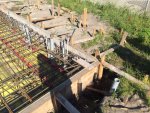woodduder
Senior Member
- Location
- West Central FL.
In the picture below you can see a 1" PVC conduit (protective sleeve) with our 1/0 copper wire that is connected to the footer steel. You cannot see the connection but it is adjacent to the pipe and just above the vapor barrier. I know that the code 250.52 (A) (3) informational note states that the vapor barrier would make the concrete considered not in direct contact with earth, but every slab we do has a vapor barrier and that is the "way it has been done for years" here in SW Florida. The footer inspector is responsible to confirm there is an electrode attached, which he did and inspection passes.
Move ahead 9 months and we are now trying to get a final inspection. The electrical inspector asks about the footer ground. The picture below is shown to him and he says "no good" because of the vapor barrier. He wants another footer poured next to building or a 3rd party ground test performed even though we have three 10' ground rods in a triangle just outside which makes us code compliant anyway. He is being unreasonable in my opinion.
Now my question: The vapor barrier is only at the bottom of the footer. The footer is 24" deep and 16" of the footer's side (where the plywood form was) is in direct contact with earth. Do you think our footer is "in direct contact with earth"?
Move ahead 9 months and we are now trying to get a final inspection. The electrical inspector asks about the footer ground. The picture below is shown to him and he says "no good" because of the vapor barrier. He wants another footer poured next to building or a 3rd party ground test performed even though we have three 10' ground rods in a triangle just outside which makes us code compliant anyway. He is being unreasonable in my opinion.
Now my question: The vapor barrier is only at the bottom of the footer. The footer is 24" deep and 16" of the footer's side (where the plywood form was) is in direct contact with earth. Do you think our footer is "in direct contact with earth"?



